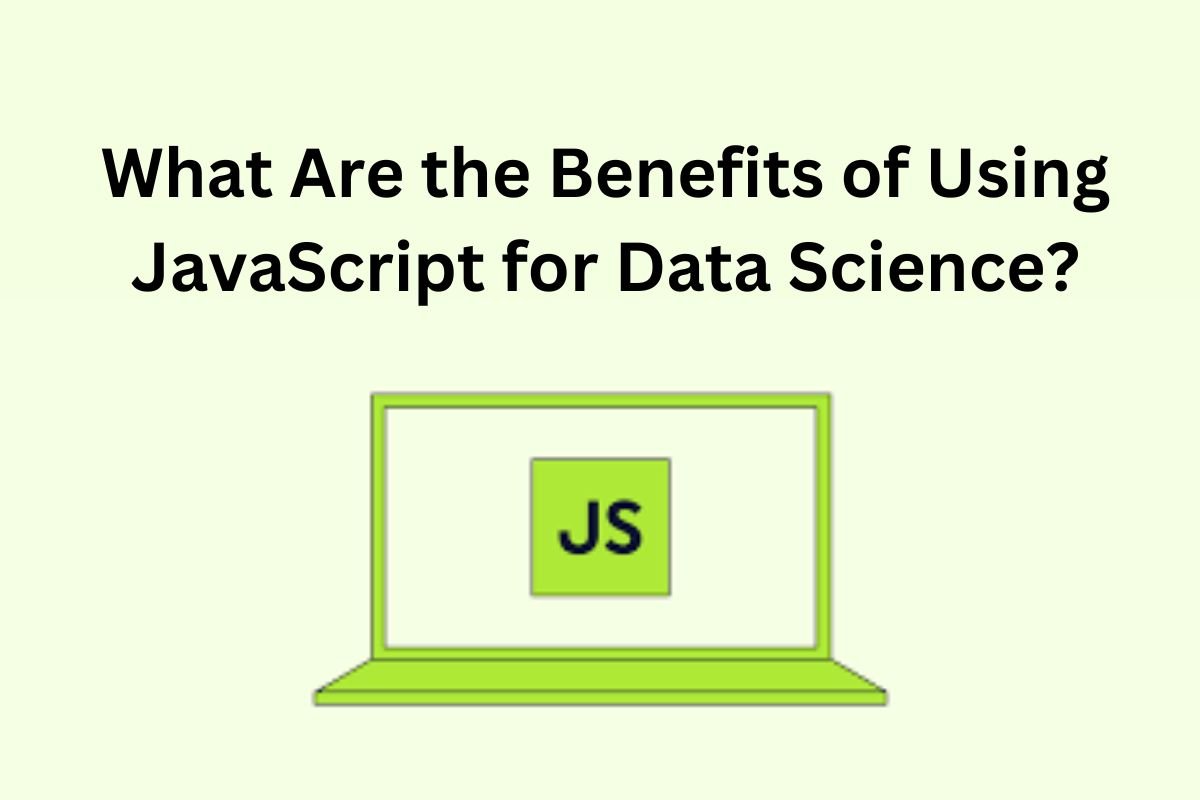Introduction
JavaScript is mostly used for building websites, but now it’s also helpful in data science. While Python and R are more popular, JavaScript has its own benefits, like making data visualizations and handling real-time data. It’s becoming a useful tool for some data science tasks. Here’s a simple look at how it can help in data science.
What is JavaScript?
JavaScript is a flexible programming language mainly used to build websites. It helps add interactive features like animations, dynamic content, and form checks. JavaScript works both in the browser (client-side) and on servers (with Node.js), making it possible to create web apps, display data, and even run machine learning. This makes it key for today’s online experiences.
What is Data science?
Data science is the field of using data to solve problems, make decisions, and discover insights. It involves collecting, analyzing, and interpreting large sets of data using tools like statistics, programming, and machine learning. By turning raw data into meaningful information, data science helps businesses, researchers, and organizations make smarter choices and understand trends better.
Benefits of Using JavaScript For Data Science
1. Integration with Web Technologies
JavaScript is the backbone of web development, which means it integrates seamlessly with web technologies like HTML and CSS. This makes JavaScript a powerful choice for building interactive data visualizations and dashboards that can run directly in the browser.
For instance, if you’re working on a data science project and want to present your findings in an interactive way, JavaScript makes it easy to embed those visualizations on a website. You can even create real-time data visualizations that update dynamically without needing to refresh the page.
Key Benefit:
- Seamless integration with the web.
- Easier to create interactive, web-based dashboards and visualizations.
2. Client-Side Processing
One of the unique features of JavaScript is its ability to run directly in the browser, which allows for client-side data processing. Unlike server-side languages like Python, JavaScript can process data on the client-side, reducing the load on the server and improving overall performance.
For example, if you’re developing a web-based data science app that needs to process user data or perform some analytics in real-time, JavaScript can handle the processing within the browser itself, making the user experience faster and more efficient.
Key Benefit:
- Faster processing of data within the browser.
- Reduced server load.
3. Libraries and Frameworks for Data Science
JavaScript has a growing ecosystem of libraries and frameworks that make it easier to perform data science tasks. Here are a few notable libraries that are useful in data science:
- D3.js: D3.js is one of the most popular libraries for creating complex, interactive data visualizations. It allows you to bind data to the Document Object Model (DOM) and apply data-driven transformations.
- TensorFlow.js: TensorFlow.js allows you to build and train machine learning models directly in the browser using JavaScript. It brings the power of TensorFlow, a popular machine learning framework, to JavaScript.
- Chart.js: A simple and flexible library for creating basic charts and graphs that can be easily integrated into web applications.
- Danfo.js: Danfo.js is a JavaScript library that mimics the functionality of Python’s Pandas, making it easier to handle and manipulate data.
Key Benefit:
- Access to specialized libraries like D3.js, TensorFlow.js, and Danfo.js for data science and visualization.
- Growing support for machine learning and data manipulation in JavaScript.
4. Cross-Platform Compatibility
One of the key advantages of using JavaScript for data science is its cross-platform compatibility. JavaScript works across different browsers and devices, which makes it an excellent choice for building applications that can be accessed by users on various platforms, including desktops, laptops, tablets, and smartphones.
This cross-platform nature makes JavaScript ideal for building data-driven applications or dashboards that need to be accessible to a broad audience, no matter what device they’re using.
Key Benefit:
- Works across different devices and browsers.
- Ideal for reaching a wide audience with web-based data applications.
5. Real-Time Data Handling
JavaScript excels in real-time data handling, which is essential for certain types of data science applications, like monitoring live data streams. JavaScript can easily handle WebSocket connections, APIs, and live data feeds, making it ideal for projects where real-time data is crucial.
For example, if you’re working on a project that involves stock market data or IoT (Internet of Things) devices that send live updates, JavaScript can be used to process and display this data instantly without needing to reload the page.
Key Benefit:
- Handles real-time data effectively.
- Ideal for projects that involve live data streaming.
6. Growing Popularity in Machine Learning
While Python has been the leader in machine learning, JavaScript has made significant strides in this area, especially with the introduction of TensorFlow.js. TensorFlow.js allows data scientists and developers to run machine learning models in the browser or on Node.js, opening up new possibilities for building intelligent web applications.
With TensorFlow.js, you can create, train, and deploy machine learning models entirely within the browser, making it easier for developers to add AI features to their web-based applications.
Key Benefit:
- Supports machine learning models through TensorFlow.js.
- Expands the potential for AI in web-based applications.
7. JavaScript and Node.js for Server-Side Data Processing
While JavaScript is mainly known for client-side programming, it can also be used for server-side data processing through Node.js. Node.js is a JavaScript runtime that allows you to run JavaScript on the server, enabling you to build back-end services that handle data processing tasks like fetching data from databases, cleaning data, or running data analytics.
For instance, if you’re working on a project that requires both a front-end interface and a back-end server for data processing, using JavaScript (via Node.js) for both sides simplifies the workflow. You can write both the client-side and server-side code in JavaScript, reducing the need to switch between languages.
Key Benefit:
- JavaScript can be used for both front-end and back-end data processing.
- Simplifies development by using a single language (JavaScript) for the entire stack.
8. Ease of Learning and Use
JavaScript is one of the most popular programming languages in the world, and many developers are already familiar with it. This familiarity can make it easier for developers to transition into data science roles or add data science capabilities to their existing skillset without needing to learn a new language from scratch.
Additionally, JavaScript’s syntax is relatively simple and easy to understand, making it a good option for beginners who want to explore data science.
Key Benefit:
- Easy to learn for beginners and familiar to web developers.
- Reduces the learning curve for developers transitioning into data science.
For beginners who are keen on learning data science, a Data Science Training Course in Noida, Delhi, Gurgaon, and other locations in India offers an ideal starting point.
9. Rich Ecosystem and Community Support
JavaScript has a vast community of developers and an extensive ecosystem of tools, frameworks, and libraries. This ecosystem offers excellent resources for learning, troubleshooting, and enhancing your data science projects. With platforms like GitHub, Stack Overflow, and numerous open-source projects, you can find solutions to almost any problem you encounter in your data science journey.
Key Benefit:
- Strong community support and vast resources.
- Access to a wide range of tools and frameworks.
Conclusion
While JavaScript might not be the first language that comes to mind when you think of data science, it offers a variety of benefits that make it a worthy contender. From real-time data handling and seamless web integration to a growing number of libraries and machine learning frameworks like TensorFlow.js, JavaScript brings flexibility and convenience to data science tasks.
Whether you’re looking to create interactive data visualizations, build web-based data applications, or explore machine learning, JavaScript has the tools and capabilities to help you succeed. It might not replace Python or R for hardcore data science tasks, but it’s an excellent addition to any data scientist’s toolkit, especially for web-based projects.
FAQs: Benefits of Using JavaScript for Data Science
1. Why use JavaScript for data science?
Answer: JavaScript is great for web-based data visualizations, real-time data handling, and seamless integration with web technologies.
2. What are the key benefits of JavaScript in data science?
Answer: Key benefits include:
- Real-time data processing.
- Interactive visualizations (e.g., D3.js).
- Machine learning support via TensorFlow.js.
3. Can JavaScript handle machine learning tasks?
Answer: Yes, with TensorFlow.js, JavaScript can run machine learning models directly in the browser.
4. Is JavaScript easy to use for data science?
Answer: JavaScript is familiar to many developers and has a growing set of tools for data science, making it easier to learn and use for web-based projects.
Also Read : https://empireadda.com/complete-digital-marketing-syllabus-everything-you-need/



